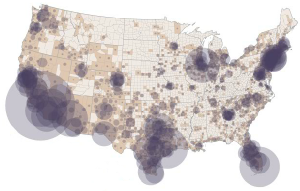Mexican Americans Key To Future Latino Growth In The U.S.
 The Pew Hispanic Center has released a new set of data that allows readers to get a more spatial understanding of Hispanic populations in America. This interactive map spans 1980 to the present, and shows the important things about Hispanic migration and population expansion. Not only does it allow us to get a visual perspective of the growth, it also allows the readers to look at the shifts in the Hispanic cultural hubs of America, and see where the Hispanic population really isn’t growing.
The Pew Hispanic Center has released a new set of data that allows readers to get a more spatial understanding of Hispanic populations in America. This interactive map spans 1980 to the present, and shows the important things about Hispanic migration and population expansion. Not only does it allow us to get a visual perspective of the growth, it also allows the readers to look at the shifts in the Hispanic cultural hubs of America, and see where the Hispanic population really isn’t growing.
Firstly, the population has grown immensely from 1980.
In 1980 the U.S. population was 226.5 million, 14.6 million of whom were counted as Hispanic, congregated in three cores areas: New York, Miami, and Los Angeles. By 2010, America has grown to 309 million, the Hispanic population to 50 million. Over 30 years the Hispanic population has managed to surge ahead of most groups in population, and spans a much broader area of America than it did in the 1980s — even Alasaka has a Hispanic population.
The other interesting thing note to the map is the replacement of dispersed Hispanic population hearths. New York City’s metropolitan area (Bronx, Kings, and New York County on this data) during the 1980s has more than 1.1 million Hispanics, according to this data. It surpasses Miami-Dade by double, but fails to reach Los Angeles’ population. By 2000, New York State is off the list. The east coast’s Hispanic population is indeed growing — don’t think otherwise — but, likely due to immigration, the U.S.-Mexico border has become the center of America’s Hispanic population.
As a result, it’s safe to assume that the heart of Hispanic culture in our country is no longer as spread apart as it used to be between Los Angeles, Miami, and New York. The twenty-first century Hispanic culture in the U.S. will likely center around Southern California, the border, and Gulf coast populations
As stated before, Hispanics have grown in noticeable numbers across the country, aside from very minimal growth in the Dakotas and Montana. It also shows that the largest concentrations away from the border and the Gulf are in Cook County, Illinois, and the Boston-Washington D.C. megalopolis. It’s an interesting map to look at, with some valuable data on major counties for Hispanic populations, but more importantly, one that tells us a great deal about who we will be as a nation in years to come.
[Screenshot By Pew]
